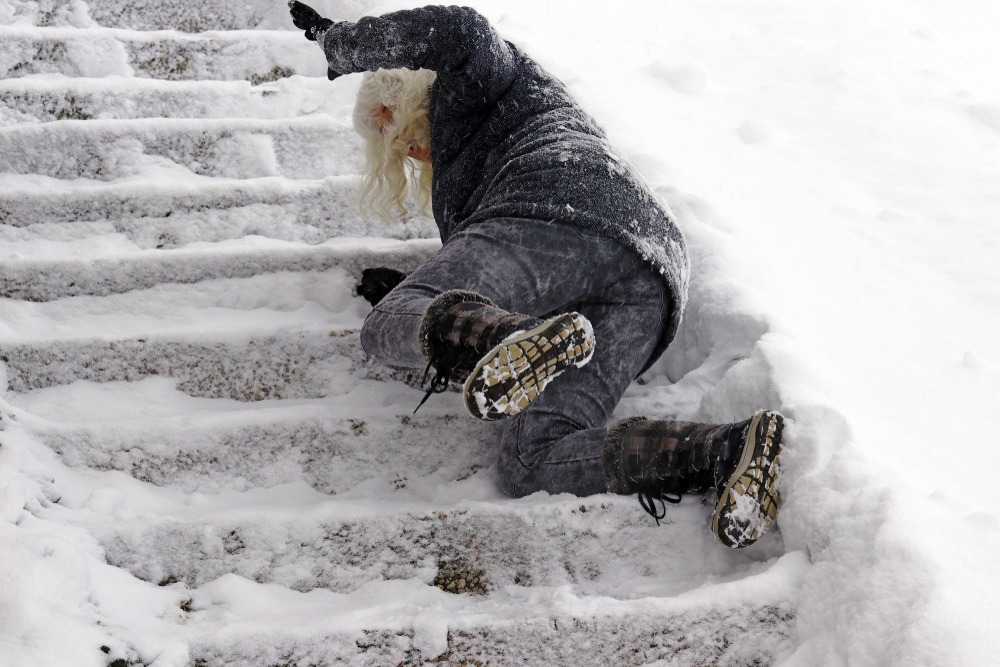You might love the snow or you might hate it. Regardless, the icy ground poses a big hazard for everyone at this time of year. Although most people think that fall injuries only happen to the elderly, they can happen to anyone. In some cases, falling the wrong way can even lead to serious injuries like a broken bone or a concussion.
With that in mind, it’s important to know how to avoid these winter-related slip and fall injuries. Fortunately, there are some great steps that you can take to stay safe while walking outdoors this season.
Simple Tips to Avoid Falls
The biggest key to avoiding winter fall injuries is to dress properly for the weather conditions. When there is ice on the sidewalks, you’ll want to be wearing the right pair of shoes. They should have a rubber sole that provides enough traction to help you keep your footing. Look for deep grooves when you shop for a new pair. If the ice is worse than usual, or you frequently need to walk across it, you can even purchase ice grips that fit overtop of your regular shoes.
In addition to the right pair of shoes, you should dress warmly in a jacket with enough layers underneath. This will help you avoid rushing to get out of the cold and slipping in the process. When there is ice on the ground, always remember to take your time walking from place to place. Many falls happen just feet from where a person steps outside.
Winter Accidents and Orthopedic Injuries
When a person slips and falls there are several types of injuries that can occur. Understandably, the most common type deals with the bones. These are known as orthopedic injuries and may need special treatment depending on how severe they are.
In the winter, ice-related falls typically result in injuries to the wrist, ankle, or shoulder. When you reach out to try and stop a fall, you can actually do significant damage to your joints and bones. For example, trying to brace a fall with an extended arm could result in a broken wrist and dislocated shoulder. While not all falls will cause injuries this severe, they could.
Some falls can also injure the lower back depending on how you hit the ground. If you slip backwards you can easily pull a muscle or bruise the area upon landing. This can lead to pain and swelling for days or weeks after.
Winter Accidents and Concussions
Another common type of injury that occurs during a fall in the winter is a concussion. This happens when part of your head (typically the back) hits either the ground or a hard chunk of ice. A concussion is a form of traumatic brain injury that is the result of your brain bouncing off the inside of your skull.
Although many people believe that a concussion only happens if they lose consciousness, that isn’t true. It’s possible to get a concussion even if you don’t lose consciousness after hitting your head.
Know When to Seek Help
In many cases, a fall on the ice will leave you sore and embarrassed but doesn’t warrant medical treatment. However, sometimes it causes more serious injuries. When these occur, it’s important to know when you should seek treatment from a medical professional.
One of the most concerning injuries is a broken bone. When this occurs, it might be obvious or it may be subtle. In either case, it is typically accompanied by sharp, sudden pain after your fall. The injured area will also start to swell and may develop bruising. In some cases, the broken bone may actually protrude through the skin. This is known as a compound fracture. If any of these signs are present, you should visit urgent care or the emergency room immediately.
If you fall and hit your head, you should also be aware of the signs of a concussion. These include a headache, nausea, memory loss, difficulty concentrating, dizziness, vision abnormalities, and confusion. If you have any of these symptoms after hitting your head in the hours, days, or weeks that follow, you should visit urgent care or the emergency room. However, it is best to have someone else drive you in case your symptoms worsen on the way.
Velocity Urgent Care Has Your Back
If your winter walk turns into a slip and fall, Velocity Urgent Care has your back. Whether you experience a broken bone, a sprained wrist, or a concussion, our board-certified physicians and friendly staff will get you on the mend in no time. Our 14 locations across Virginia are equipped with state of the art technology and X-ray machines so we can determine the problem on-location.
You can walk in at any time thanks to our convenient hours that are designed to fit your schedule. Velocity Urgent Care is also the exclusive in-network provider for several local insurance plans, meaning you can be seen for the cost of your co-pay and deductible. All of our locations also accept Medicare, Medicaid, and Tricare and we are an authorized Veterans Administration provider.
To find out more about our services, locations, hours, and more, visit www.velocityuc.com.

